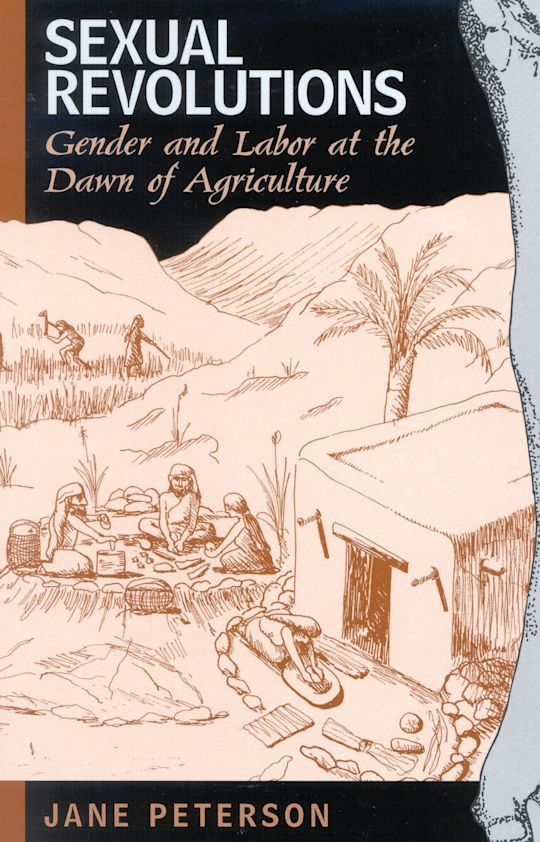- Home
- ACADEMIC
- Archaeology
- Archaeology - Other
- Sexual Revolutions
Exam copy added to basket
Choose your preferred format. Please note ebook exam copies are fulfilled by VitalSource™.
Buy from Bloomsbury eTextBooks
You are now leaving the Bloomsbury Publishing website. Your eBook purchase will be with our partner https://www.vitalsource.com.
Your credit card statement will show this purchase originating from VitalSource Technologies. They will also provide any technical assistance you might require.
You must sign in to add this item to your wishlist. Please sign in or create an account
Description
The change from a hunting-gathering lifestyle to one dependent upon farming constitutes a truly 'revolutionary' event in the human career. Most archaeologists agree that how ancient people organized their work and family groups was crucial to the success of early attempts at farming. Yet little serious attention has been paid to the social organization of labor in the prehistoric past. This book addresses that lacuna by investigating sexual divisions of labor. As a case study, Peterson chose the southern Levant of West Asia, where the world's first farming societies emerged some 10,000 years ago. Shattering long held assumptions about women's work that lead to generalizations about gender roles, Peterson shows that gender studies can be both scientific and thoroughly grounded in feminist theory.
Table of Contents
Part 2 Chapter 1: An Investigation of Labor Patterns
Chapter 3 Work Patterns and Sexual Divisions: Historical Background
Chapter 4 Social Models in Archaeology: Past and Future
Chapter 5 Sex and Gender Terminology
Chapter 6 Study Area and Chronology
Chapter 7 Organizations
Part 8 Chapter 2: Archaeological Evidence from the Southern Levant
Chapter 9 Natufian Period
Chapter 10 Pre-Pottery Neolithic Period
Chapter 12 Chalcolithic Period
Chapter 13 Early Bronze I Period
Chapter 14 Summary
Part 15 Chapter 3: Markers of Occupational Stress
Chapter 16 Historical Overview
Chapter 17 Structural Changes
Chapter 18 Joint Modification
Chapter 19 Trauma
Chapter 20 Tooth wear, Dental Trauma, and Caries
Chapter 21 Musculoskeletal Stress Markers
Chapter 22 Summary
Part 23 Chapter 4: Occupational Evidence and Hypotheses From the Levant
Chapter 24 Extant Studies
Chapter 25 Chronological Summary
Chapter 26 Conclusions
Part 27 Chapter 5: New Musculoskeletal Stress Markers
Chapter 28 Materials
Chapter 29 Methods
Chapter 30 Analytical Techniques
Chapter 31 Natufian Results
Chapter 32 Neolithic Results
Chapter 33 Early Bronze I Results
Part 34 Chapter 6: Modeling Changing Labor Scenarios
Chapter 35 Integrating MSM with previous activity reconstructions
Chapter 36 Activities and Performance Spaces
Chapter 37 Models of Sexual Labor Changes with the Advent of Farming
Chapter 38 An Engendered Model
Part 39 Bibliography
Part 40 Index
Part 41 About the Author
Chapter 42 Neolithic Period
Product details
| Published | Sep 18 2002 |
|---|---|
| Format | Ebook (Epub & Mobi) |
| Edition | 1st |
| Extent | 192 |
| ISBN | 9780759116481 |
| Imprint | AltaMira Press |
| Series | Gender and Archaeology |
| Publisher | Bloomsbury Publishing |
About the contributors
Reviews
-
Jane Peterson's new book provides a fresh and provocative look at the dynamic nature of gender-related roles and subsistence changes in the Levant. Her work melds archaeological data with the exciting new field of habitual activity analysis, supplying the reader with a thought-provoking contribution to both bioarchaeology and gender issues.
Diane E. Hawkey, (Arizona State University)
-
'Woman's work?' All too often archaeologists and anthropologists bring their cultural baggage with them into the field and laboratory, subconsciously applying gender stereotypes to the problems they are trying to solve. Going beyond the standard rubric of 'putting flesh back on the bones,' Jane Peterson's book puts real muscle into the examination of activity diversity in males and females based on markers of occupational stress that occur on excavated skeletons. Peterson's work presents a well-balanced appraisal of the current status of views of gender/sex labor roles based on archaeological sources, feminist archaeology, and anthropology.
Gary Rollefson, (Whitman College)
-
Sexual Revolutions is superb, and, indeed, important. It has considerable significance for both general questions about the archaeology of gender and for more particular concerns about Near Eastern prehistory. Peterson presents a stimulating synthesis of theory and osteological evidence concerning the role of women in the agricultural and urban 'revolutions' of south-west Asia, with the focus on the southern Levant.
Antiquity
-
In sum, this book, the fourth book in a series on Gender and Archaeology edited by Sarah Nelson, is a gem. It introduces new hard data and judicious interpretation into a subject too often dominated by unsubstantiated but fervently held theories....it's value as a textbook: both readable and scholarly, it is a wonderful demonstration of wha science is good for. In addition to her admirably clear prose, Peterson has selected good graphic and illustrative materials.
American Antiquity
-
This book is an important one that should be read by all scholars interested in issues of labor and social organization in the archaeological record. Written in a readable and accessible style, it is both a scholarly work and one that can be easily used as a case study in classes. Peterson's work points us in a direction that many other scholars may wish to pursue.
Bulletin of the American Schools of Oriental Research
-
Sexual Revolutions provides a perspective on gender and labor that is made possible only from the insight gained from the study of ancient skeletons. Anthropologists have long speculated on the role of women and men in labor, especially in relation to the transition from foraging to farming. Peterson's interesting and compelling study of skeletal markers of activity gives new perspective on the dawn of agriculture and its impact on the lives and lifestyles of women and men. This book is a must read for physical anthropologists, archaeologists, and others interested human behavior, gender, and labor in this key period of human evolution.
Clark Spencer Larsen, (Department of Anthropology, Ohio State University)


































